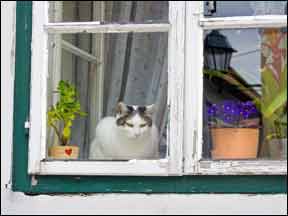Youre getting ready to leave the house, and as you put on your coat, you notice your cat Goldie eyeballing you from a few feet away. You slowly open the door, hoping to get out before he makes a run for it. But just as you squeeze through the opening, Goldie darts past you in a disappearing act that would make any magician envious. 288 For many cat owners, keeping their feline companions safely indoors represents the safest care. Cats that live indoors are not at risk of injuries from traffic or predators. An indoor cat is also less likely to be infected by fleas, ticks, intestinal parasites or life threatening viruses, and she is less likely to get lost. If you live with a cat that appreciates indoor living, keeping her inside is no problem. But if you live with a cat for which the great outdoors constantly beckons, preventing him from escaping the confines of your home requires consistent behavior modification. Experts agree that most escapes are cats that have recently spent time outside, like newly adopted stray cats, outside cats converted into indoor cats, cats that got outside by accident, etc. It seems that the call of the wild is a strong innate instinct for many cats. Your Best Defense. If your cat is sexually intact, he or she may want to wander outdoors to satisfy biological urges. This will certainly be compounded if suitors are hanging around. This yearning will be magnified during breeding season, usually spring and fall. Spaying and neutering can help keep the feline escape artist from wanting to roam, but its not a guarantee. Once a cat desires the outside world, it usually takes two things to change the behavior. One is consistency. The second key to modifying your cats behavior is time and patience. Just keep in mind that negative reinforcement doesnt work well to change feline behavior. Ways to Change Her Mind. Redirecting your cats attention with toys can be effective, or throwing the cat a favorite treat as you leave. You can keep a basket of toys or crumpled paper balls near the door to toss for your cat to chase as you exit. Youll be accomplishing two goals: giving your indoor cat a little exercise, and keeping him from escaping. You can also leave a trail of treats in a location away from the door for your cat to follow to distract him as you leave. You can also use your daily morning departure as his mealtime. Just be sure that any treats are not extra calories on top of his regular meals. You want a distracted cat, not a fat cat. You can try shaking a can of pennies when the cat starts to dart, or using a squirt bottle. The squirt bottle has the advantage of being effective when youre trying to get in the door. Just dont overdo it to the point that you create fear and distrust in your pet. If possible, install a storm or screen door in addition to your regular door to provide an extra barrier when you come or go. If your cat pushes on the window screens to let himself out, make sure the screens are securely latched, especially if you live in a high-rise apartment building. Enriching your indoor cats environment can go a long way in changing his desire to go outside. Provide a window ledge so he can see activity outside. And consider adding a bird feeder near the window to attract wildlife, if possible.



